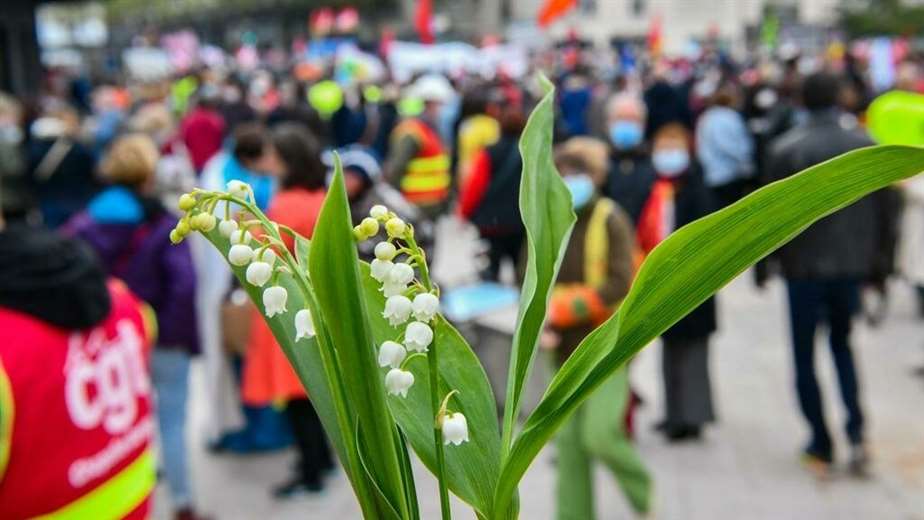This May Day 2022 in France has a special color, after the re-election of President Emmanuel Macron, in a context of political discontent on both sides of the political spectrum, especially on the left. But what is the origin of Labor Day? Here we tell you.
International Workers’ Day or May Day it is mainly the commemoration of the world labor movement. A day of protests and parades in many countries around the world, although in reality, the origins can go back centuries, since it all began a long time ago, as a pagan festival.
Pagan festival in honor of Flora and Martyrs of Chicago
The origins of May Day as a holiday that marks the beginning of summer go back to pagan antiquity. In ancient Rome, May 1 marked the climax of the Floraliasa series of festivals that lasted a week in honor of Flora, the Roman goddess of flowers.
Centuries after Christianity became the official religion in Europe, May Day was still rooted in its pagan origins, something the Puritans who took control of England after the end of the Civil War in 1649 recognized but banned related festivities. to May Day, such as the Morris dance, the garland of ribbons on the maypole, and the coronation of a May queen.
The Second International
May Day acquired its current meaning as a day of industrial action and union protest from 1889 in Paris, when an informal federation of socialist groups and trade unions from various countries founded the Second (or Socialist) International. The federation, which defended parliamentary democracy while affirming its belief in the Marxist idea of the inevitability of class struggle, decided to designate May 1 as International Workers’ Day.
The Second International chose the datepartly, to commemorate the start of Haymarket riot of 1886 in Chicago. On May 1 of that year, workers, trade unionists, socialists and anarchists met, turning Chicago into the epicenter of a movement that demanded the eight-hour workday. An estimated 35,000 participants left work to attend meetings and parade through the streets.
On May 3, police fired on protesters, killing at least one. Another rally was called to May 4which was largely peaceful until the end, when the police tried to disperse the demonstration. An unknown person threw a bomb at the police, who responded with random shots; seven police officers and at least four civilians were killed during violent events.
The American labor movement’s campaign for the eight-hour day flourished despite the violent end of the Haymarket movement. As labor historian William J. Adelman wrote: “No event has more influenced the history of labor in Illinois, in the United States, and even in the world, than Chicago’s Haymarket case.”
Wartime Boost
In subsequent years, rallies continued to be held on May 1 in many countries, increasing pressure on governments to institute the eight-hour workday.
Nevertheless, It was the bargaining power of workers in World War I that led governments to introduce the eight-hour day. In 1916, the US Adamson Act instituted the eight-hour day for railroad workers, the first US federal law to limit the number of hours private companies could have their employees work. French unions won a landslide victory when then Prime Minister Georges Clemenceau introduced the 40-hour week in 1919.
For the French trade unions, May Day remained the center of their struggles. But it wasn’t until 1947, shortly after World War II, that May 1 became a public holiday in France.
Although annual protests were temporarily banned from 1954 due to the Algerian war, demonstrations came to play a significant role in the large-scale civil unrest of May 1968.
Labor Day
Curiously, In the United States, Labor Day is always celebrated on the first Monday in September. and is called as Labor Day. Its origin is found in a parade held on September 5, 1882 in New York, organized by “The Knights of Labor” (Knights of Labor) inspired by a similar event in Toronto Canada. and it is written Work and no Labor as you might think.
Discontent in France
Today, May Day rallies and parades remain a part of the French political landscape, in many cases involving acts of violence sometimes directed at the police, often by masked and hooded anarchists or by extreme troublemakers known as los “black blocks”.
This year’s protests are expected to be larger and more angry than usual, amid the frustration of the electorate on the left, but also on the far right and in an economic context where inflation has reached 4.8% according to estimates published on April 29 by the national statistical office.
This May Day 2022 in France has a special color, after the re-election of President Emmanuel Macron, in a context of political discontent on both sides of the political spectrum, especially on the left. But what is the origin of Labor Day? Here we tell you.
International Workers’ Day or May Day it is mainly the commemoration of the world labor movement. A day of protests and parades in many countries around the world, although in reality, the origins can go back centuries, since it all began a long time ago, as a pagan festival.
Pagan festival in honor of Flora and Martyrs of Chicago
The origins of May Day as a holiday that marks the beginning of summer go back to pagan antiquity. In ancient Rome, May 1 marked the climax of the Floraliasa series of festivals that lasted a week in honor of Flora, the Roman goddess of flowers.
Centuries after Christianity became the official religion in Europe, May Day was still rooted in its pagan origins, something the Puritans who took control of England after the end of the Civil War in 1649 recognized but banned related festivities. to May Day, such as the Morris dance, the garland of ribbons on the maypole, and the coronation of a May queen.
The Second International
May Day acquired its current meaning as a day of industrial action and union protest from 1889 in Paris, when an informal federation of socialist groups and trade unions from various countries founded the Second (or Socialist) International. The federation, which defended parliamentary democracy while affirming its belief in the Marxist idea of the inevitability of class struggle, decided to designate May 1 as International Workers’ Day.
The Second International chose the datepartly, to commemorate the start of Haymarket riot of 1886 in Chicago. On May 1 of that year, workers, trade unionists, socialists and anarchists met, turning Chicago into the epicenter of a movement that demanded the eight-hour workday. An estimated 35,000 participants left work to attend meetings and parade through the streets.
On May 3, police fired on protesters, killing at least one. Another rally was called to May 4which was largely peaceful until the end, when the police tried to disperse the demonstration. An unknown person threw a bomb at the police, who responded with random shots; seven police officers and at least four civilians were killed during violent events.
The American labor movement’s campaign for the eight-hour day flourished despite the violent end of the Haymarket movement. As labor historian William J. Adelman wrote: “No event has more influenced the history of labor in Illinois, in the United States, and even in the world, than Chicago’s Haymarket case.”
Wartime Boost
In subsequent years, rallies continued to be held on May 1 in many countries, increasing pressure on governments to institute the eight-hour workday.
Nevertheless, It was the bargaining power of workers in World War I that led governments to introduce the eight-hour day. In 1916, the US Adamson Act instituted the eight-hour day for railroad workers, the first US federal law to limit the number of hours private companies could have their employees work. French unions won a landslide victory when then Prime Minister Georges Clemenceau introduced the 40-hour week in 1919.
For the French trade unions, May Day remained the center of their struggles. But it wasn’t until 1947, shortly after World War II, that May 1 became a public holiday in France.
Although annual protests were temporarily banned from 1954 due to the Algerian war, demonstrations came to play a significant role in the large-scale civil unrest of May 1968.
Labor Day
Curiously, In the United States, Labor Day is always celebrated on the first Monday in September. and is called as Labor Day. Its origin is found in a parade held on September 5, 1882 in New York, organized by “The Knights of Labor” (Knights of Labor) inspired by a similar event in Toronto Canada. and it is written Work and no Labor as you might think.
Discontent in France
Today, May Day rallies and parades remain a part of the French political landscape, in many cases involving acts of violence sometimes directed at the police, often by masked and hooded anarchists or by extreme troublemakers known as los “black blocks”.
This year’s protests are expected to be larger and more angry than usual, amid the frustration of the electorate on the left, but also on the far right and in an economic context where inflation has reached 4.8% according to estimates published on April 29 by the national statistical office.
;


















